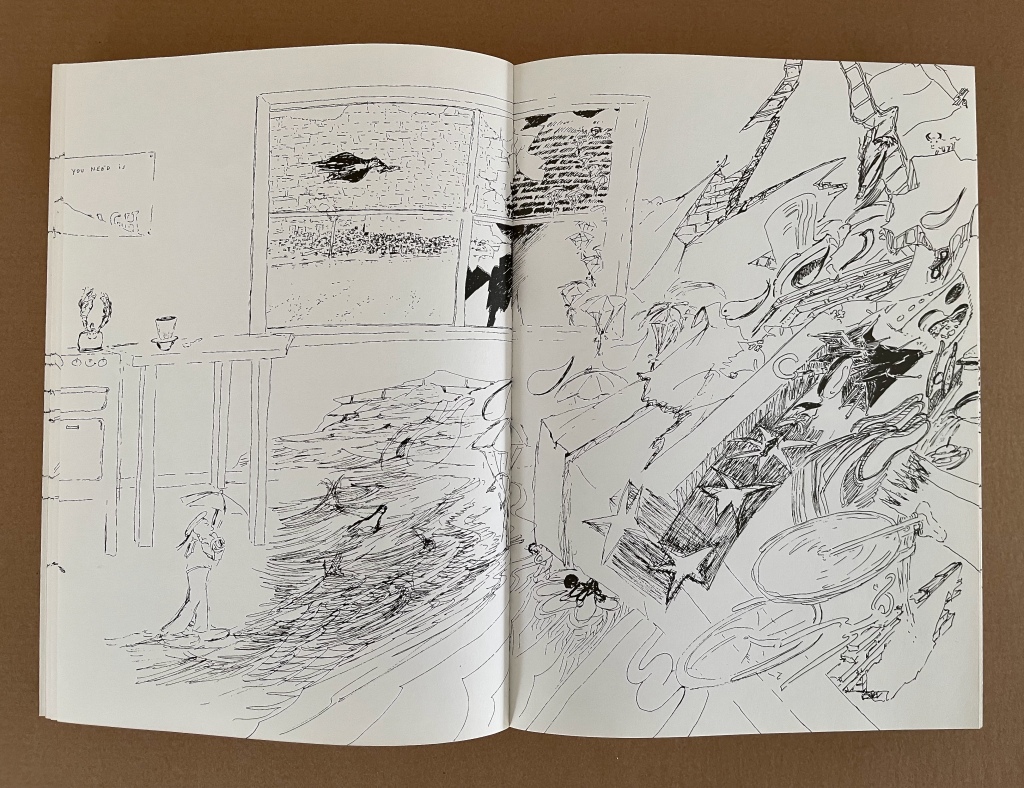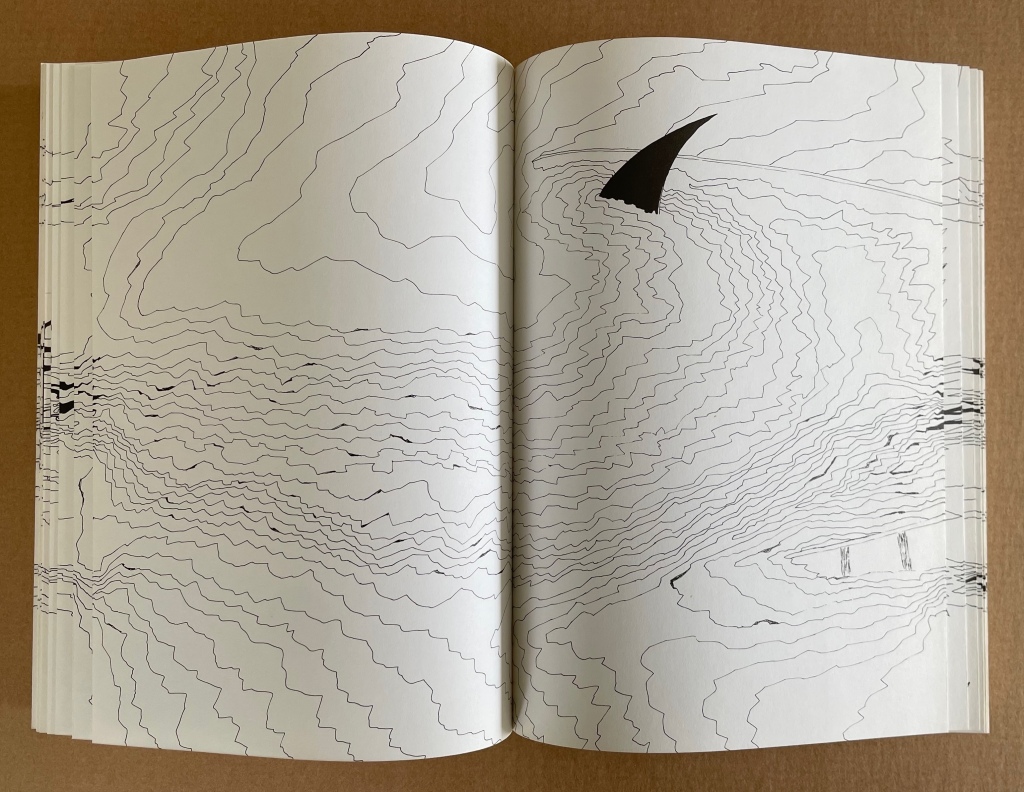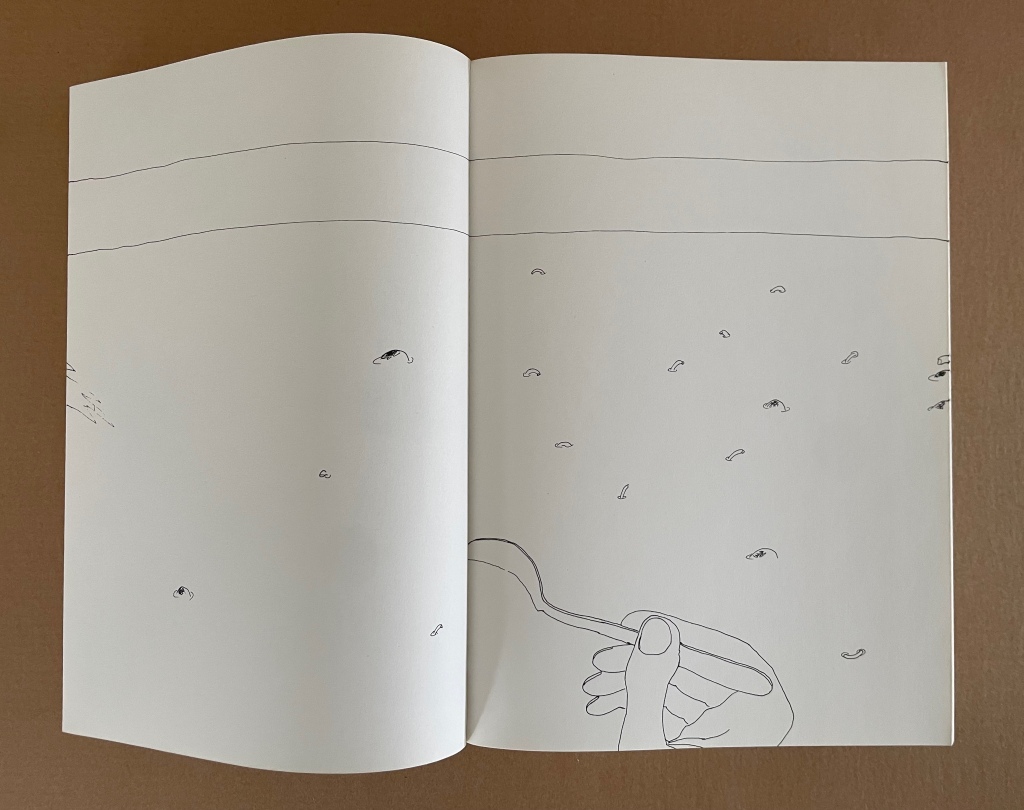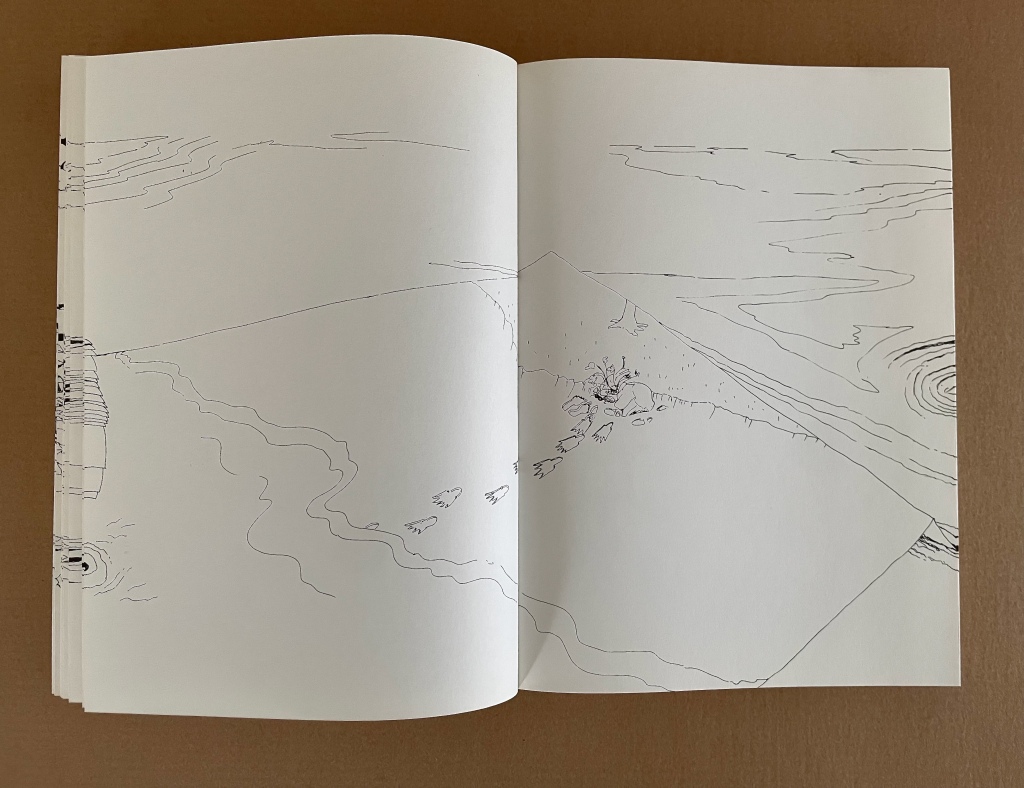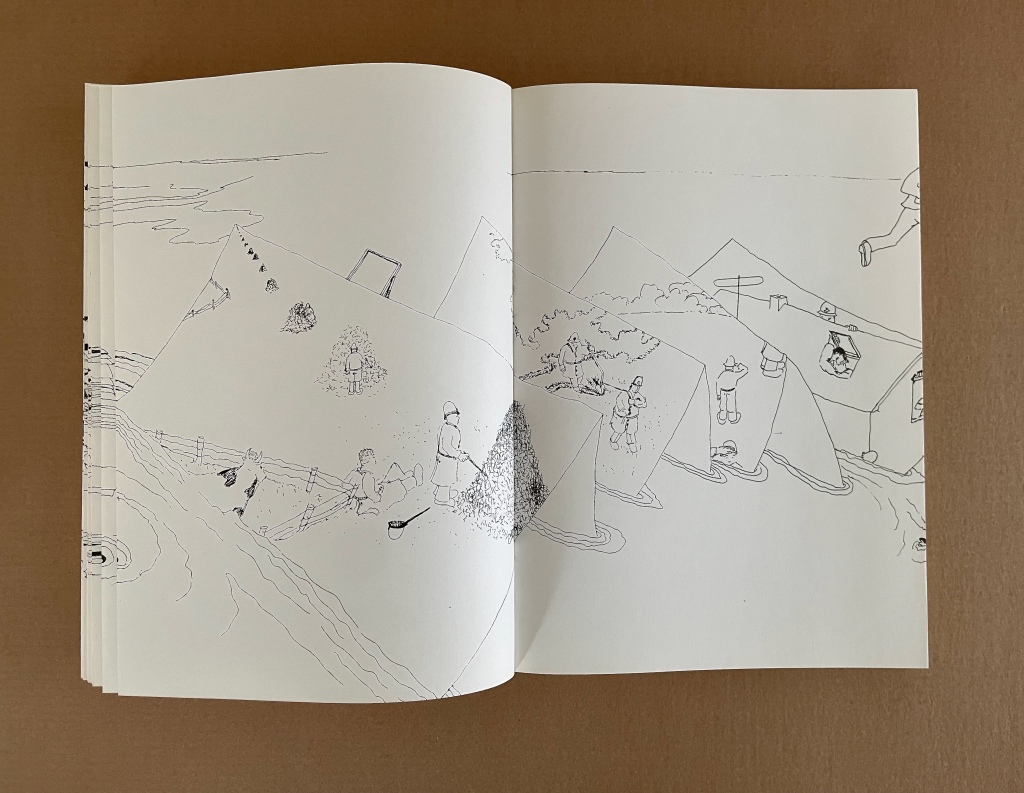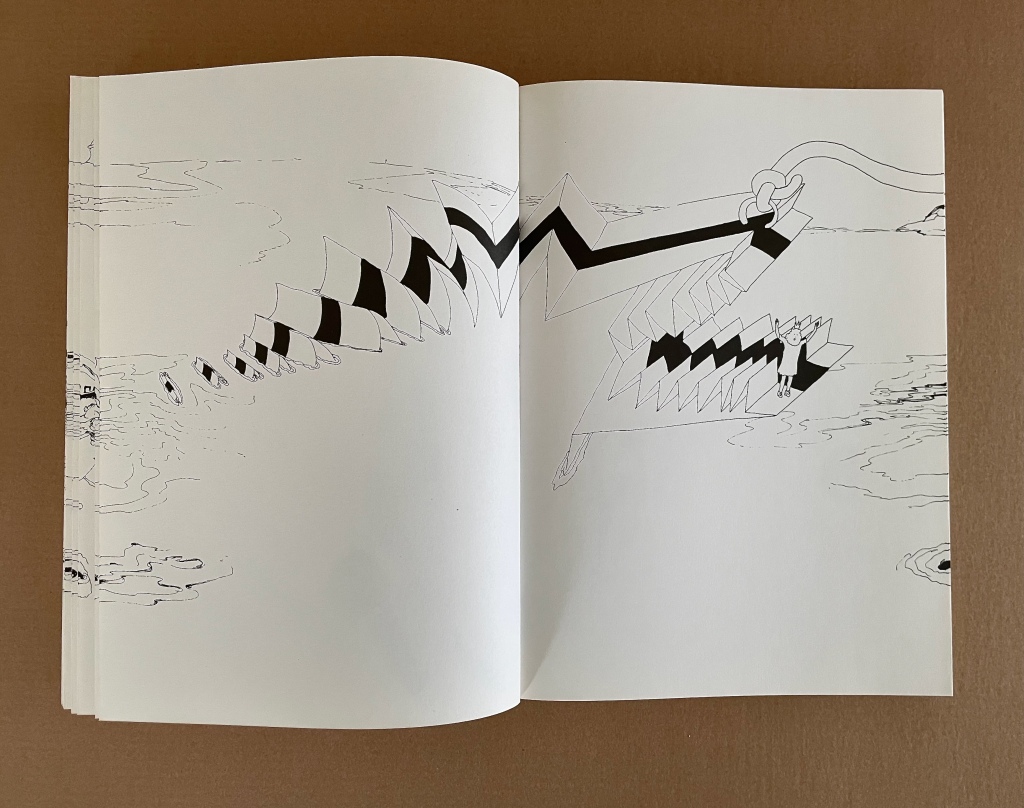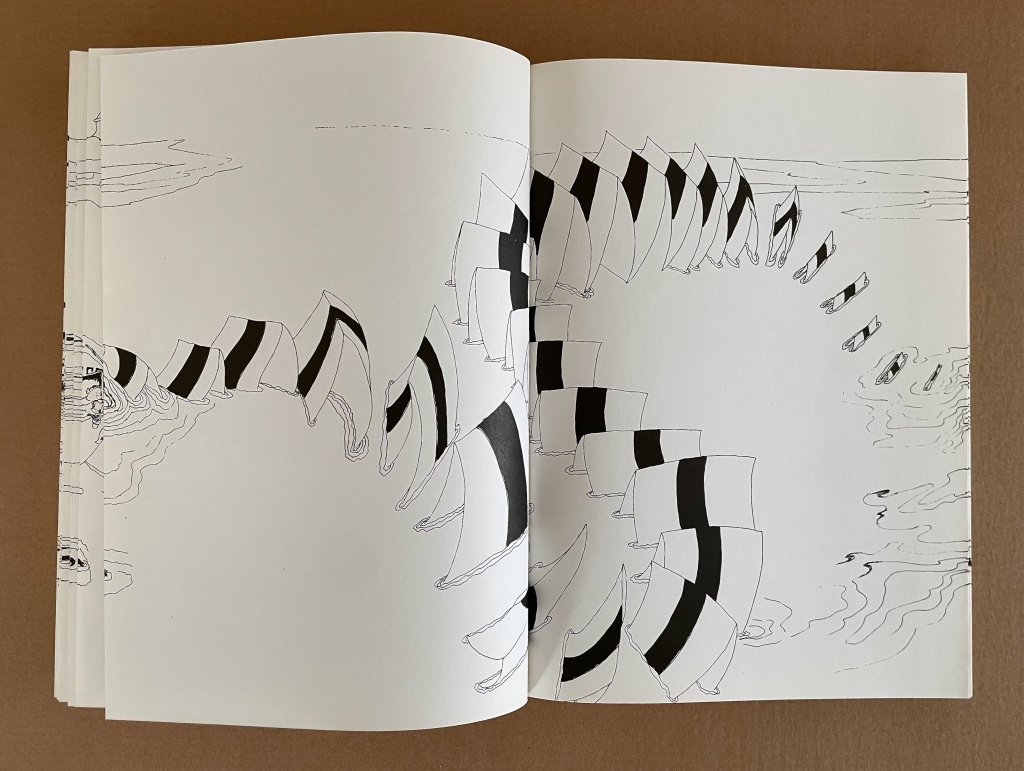In a video prepared for the Virtual Tokyo Art Book Fair in 2020, Jan Voss speaks of getting artists’ book viewers into a state of mind where they allow themselves to be surprised (9’14”). His artist’s book Detour (1989) does just that.
Detour (1989)

Detour 1989
Jan Voss
Open sleeve slipcase, softcover side-sewn and glued bifolios. 180 pages. Edition of 1000, of which this #568, signed and dated in pencil by the artist on the last page. Acquired from Antiquariat Uhlmann (Zürich, Switzerland), 10 April 2024.
Photos: Books On Books Collection. Displayed with the artist’s permission.
On its front cover, a man in white braces himself on a small patch of land and pulls a rope tight, across which a man in black man, balancing a cloud over a larger island below, walks toward the cover’s edge. But the rope, the cloud and the island disappear at the cover’s edge or rather around the cover’s edge and onto the fore-edge of the book. Because of the pages’ edges, the rope vibrates, the cloud seems to rain on it and the island below. The island has a castle or some sort of building in the middle ground reflected with the jiggled lines in the body of water in the foreground. The island, the tightrope and body of water continue around the fore-edge and onto the back cover, where it seems that the first man in white has reappeared, still on a small patch of land and still pulling the rope tight. Whaaat?
Of course, the fore-edge part of the image is visible under the pressure of the closed book, but as the sleeve slip case is removed, here come more surprises as the drawing dips into the opening fore-edge and becomes a kind of expanding image. In the video, Voss calls the fore-edge image the “shorter version” of the longer story inside.
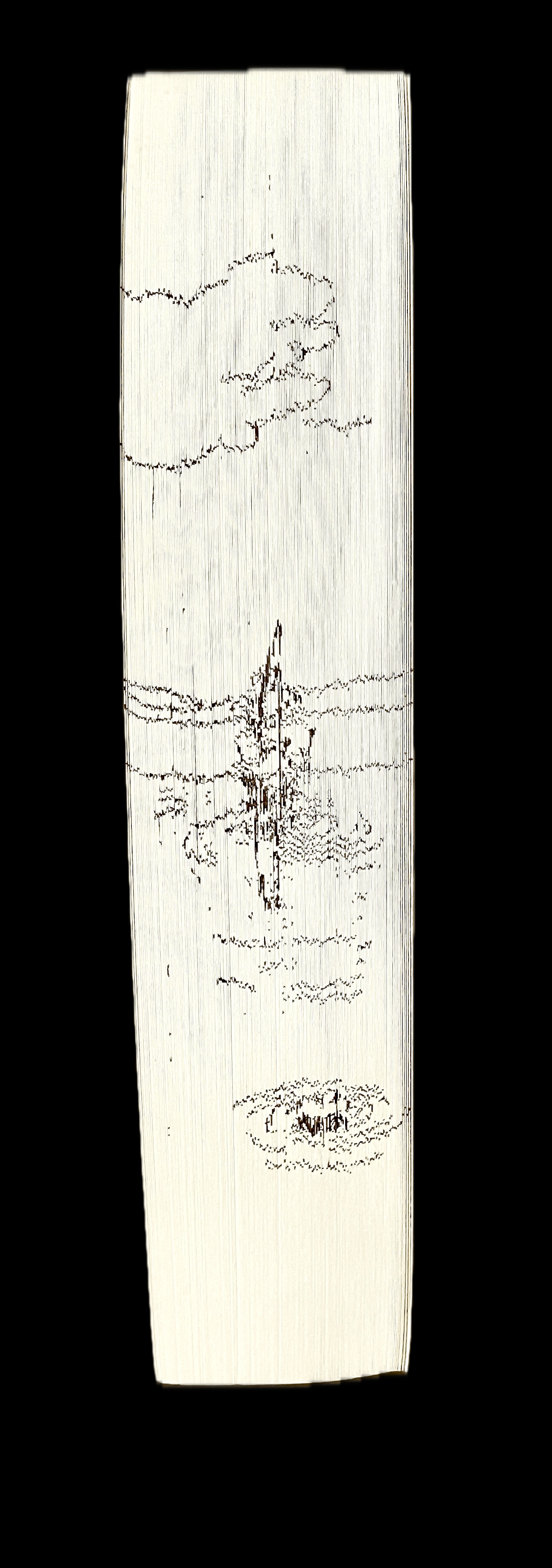

The next of the many tensions and surprises occurs on the first double-page spread (below). A character in a top hat cuts the tightrope across which the cloud-arranging character on the cover is walking. And so begins a detour.
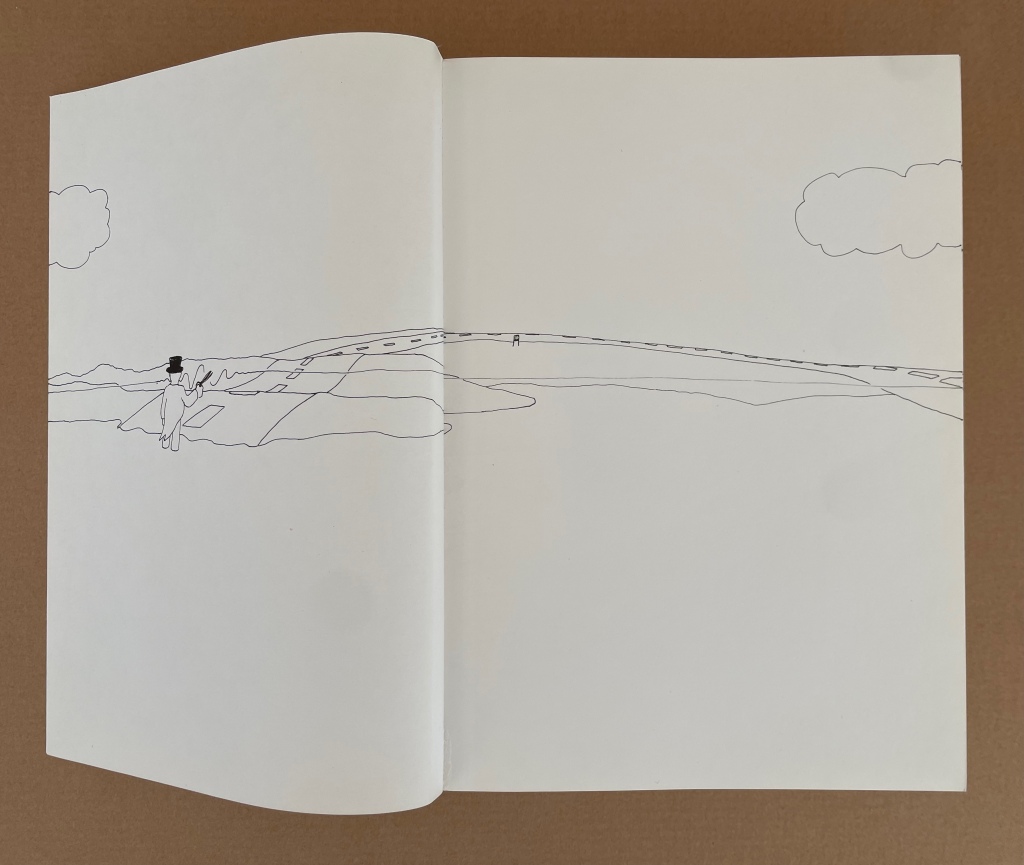
The inner story takes the broken rope or line on a long, surreal journey full of events, transformations from rural landscapes to seascapes to cityscapes and jungles, dreams, arrivals and departures, a train station, a museum, foreign and domestic scenes, the arrival of calamities and the calm of hope.
Storms and floods arrive. Sharks lurk and circle — in the strangest places.
Another element of surprise and tension is perspectives — and not just the perspective of near and far but of in and out, of up and down, and of Escher-like reversals.
These four double-page spreads in sequence from left to right offer a “souprise” perspective — in the soup, bailing out, down the drain, watering a tree.
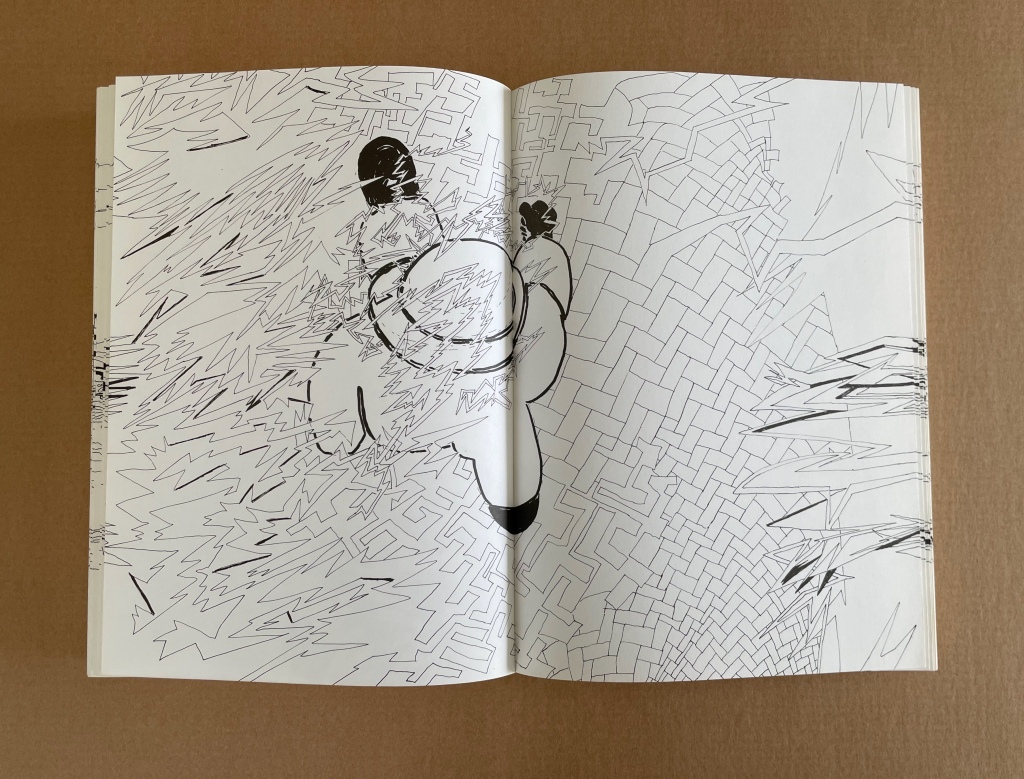
Top-down perspective.
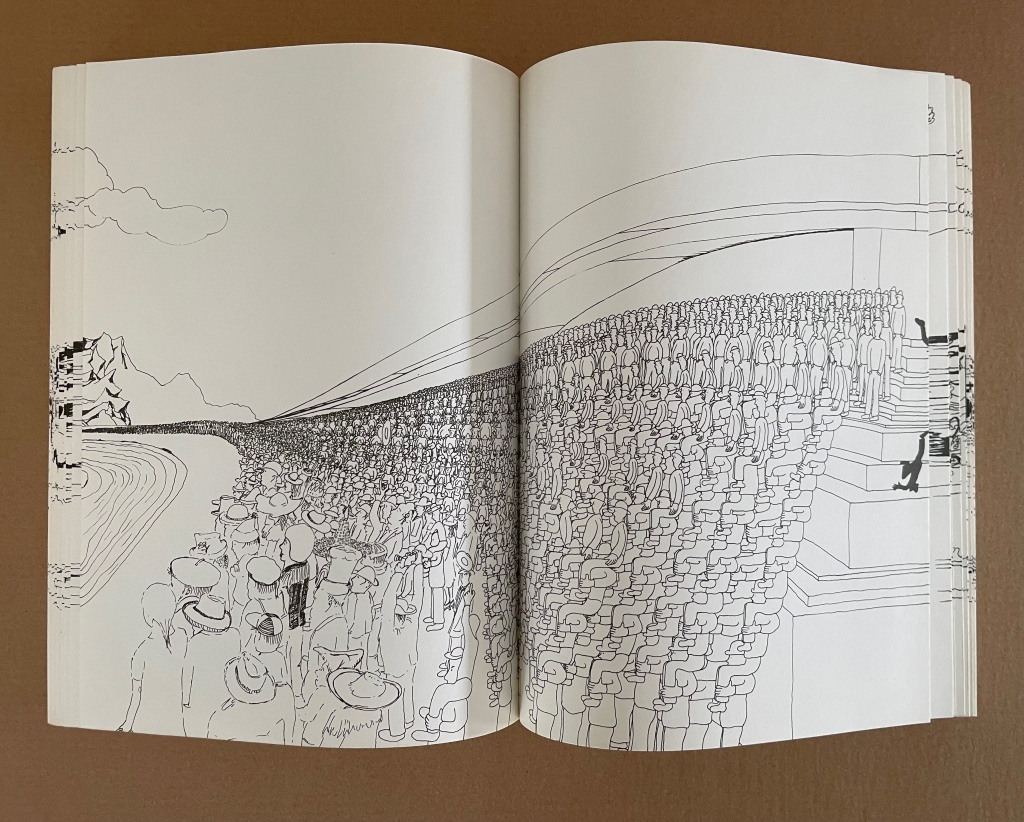

Two double-page spreads in sequence playing with perspective and an Escher-like reversal.
Setting up another source of tension and surprise is the direction of drawing as the pages turn. Sometimes two directions are in opposition as above with the multitude all gazing right to left while the builders of their seating march off left to right and upside down at that. Also as aabove, the oppositional direction can involve a surprising change of scene. The sequence below delivers another change of scene, but only the lone figure on the first verso page offers opposition to the direction of forces from the several pages following.
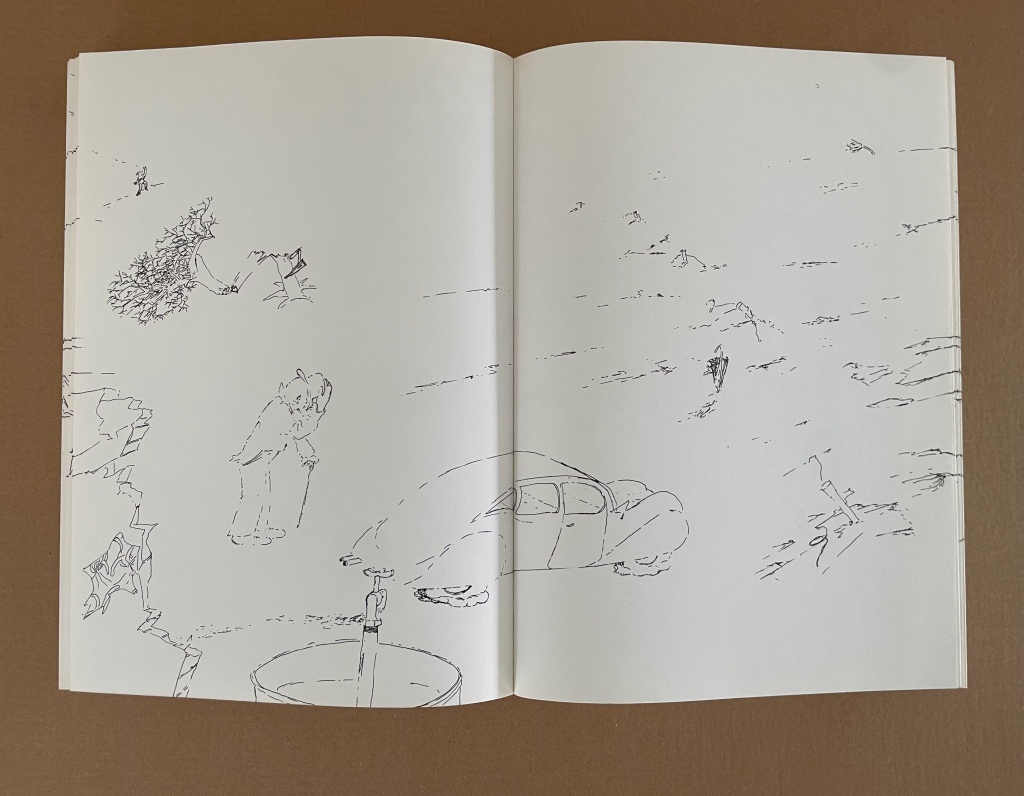

A figure with a cane struggles from left to right against the wind blowing from right to left, and he and the flat-tired auto give way to the agricultural scene from which the wind is blowing on the next double-page spread.
Artists’ books are often self-referential or self-reflexive. Voss not only embraces this characteristic several times in Detour with the drawn artist drawing the drawing (a self portrait), he uses it with oppositional direction to surreal effect to generate surprises.

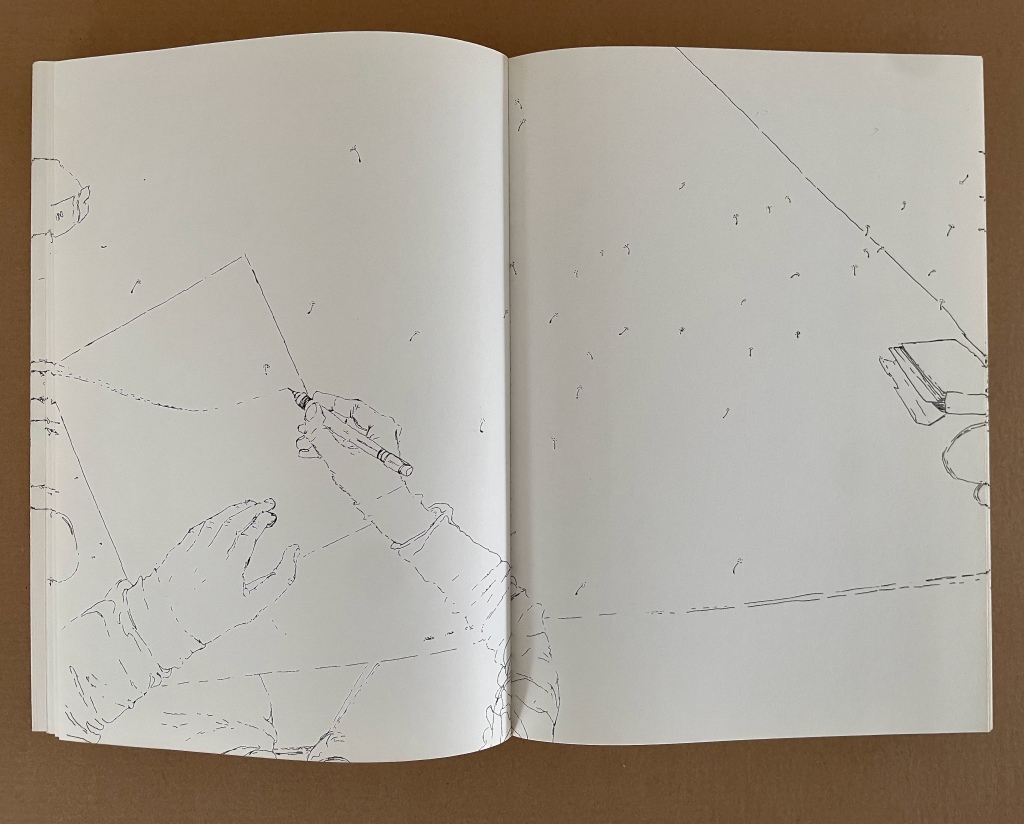
Examples of the drawn artist drawing the drawing.
The most interesting sequence of self-reflexivity has the bifold structure of the book grow from the edge of a table. The artist with a book and seated at a slanting table stirs and sloshes liquid from what appears to be a flower pot. Instead of spilling on the table in the direction of the slant, it flows backwards as it were to the previous page. More to the point in this double-page spread, though, is the small snorkel-wearing figure in the lower right. He is treading water, whose ripples overlap the edge of the table. He has arrived here from the pages about to be turned where we can see the imprints of his flippers leading down the sand and into the water, but that strand leads up to a peak, after which on the next pages more and more peaks appear. They are the creases in a long series of bifolds, an accordion book wading across the water until a cord attached to a crease pulls a stretch of it up into the air. Various images appear on the bifolds’ halves, and they are as various and diverse as those appearing in the book so far. The last one of them as the accordion is hoist upwards is a king gesticulating. He’s been seen before, asleep in his bed counting sheep that become clouds. Only when the page is turned does the hoisting cord reveal itself to be a huge strand of yarn that dwindles in size into the hands of a woman sitting on a bench on an patch of land surrounded by water and calmly knitting a sock.
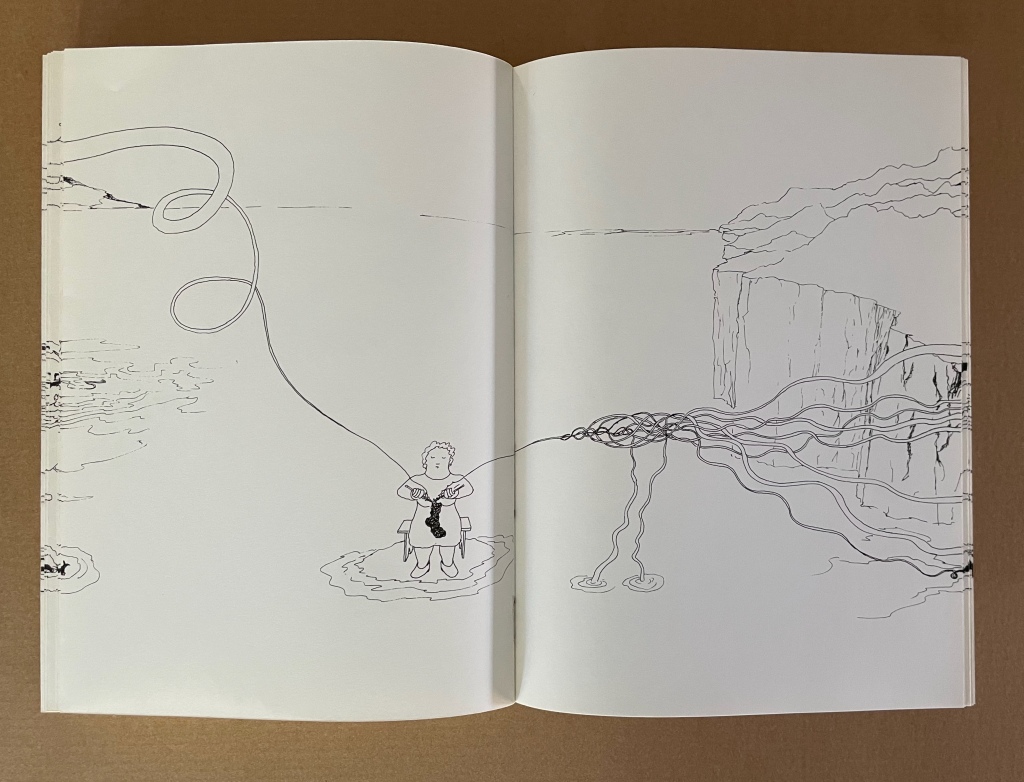
If this is Detour‘s Penelope knitting and unknitting that sock, she is far more productive than the original since her unknitted yarn goes on to deliver even more surprises in the book before it extends a life ring to its King Odysseus and artist.
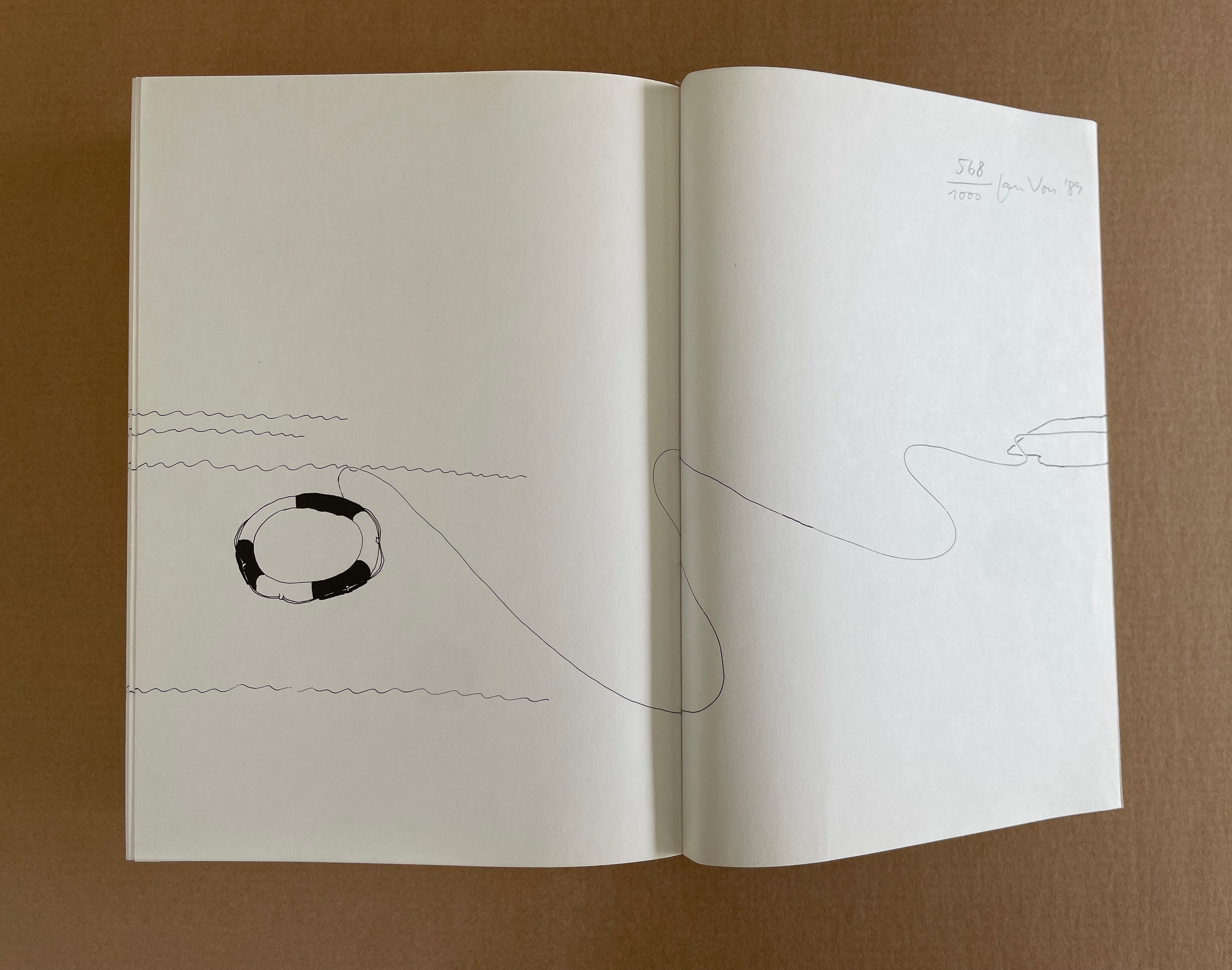
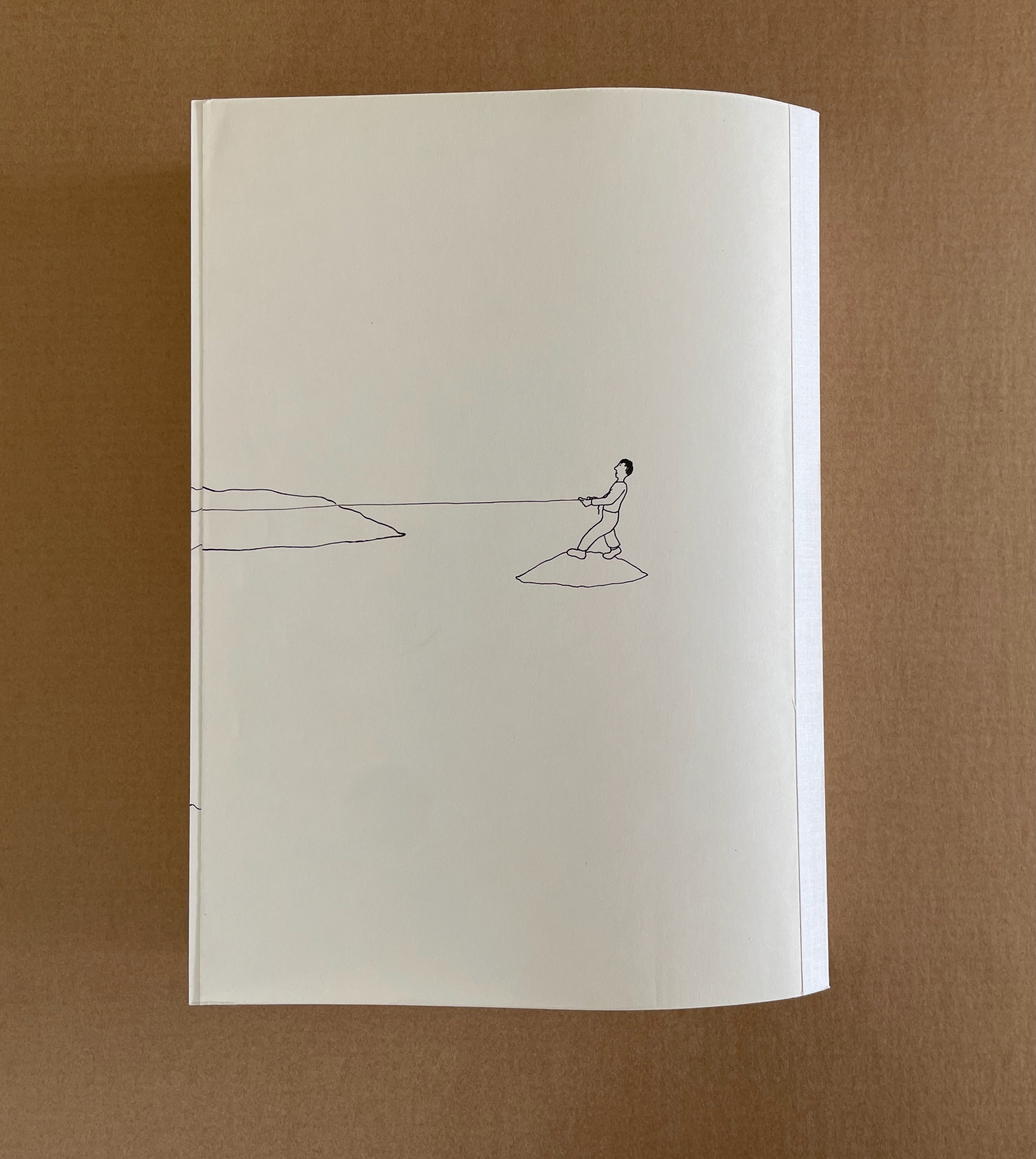
Calm waters and the hope of rescue.
The literary allusion is no more far-fetched than the religious allusion on the page where a Moses-figure gazes out as the drawing leaves him behind on his prominence or the artistic allusion in the agricultural scene above where Millais’ The Sower strides. After all, Detour is every bit as epic and inventive as Homer’s poem, and to find all of its surprises will require as many re-readings and journeys among its drawn archipelagos.
*Drucker, p. 205.
Further Reading & Viewing
“Ellen Lanyon“. 25 June 2024. Books On Books Collection. For comparison of Detour with Transformations I (1977).
Drucker, Johanna. 2004. The Century of Artists’ Books [Second edition] ed. New York City: Granary Books.
“Jan Voss, Detour, 1989“. Thomas J. Watson Library, The Metropolitan Museum of Art. Alternate link.
“Voss, Jan – Detour“. N.D. Artists’ Books.
“Jan Voss – Boekie Woekie“. 2020. Dutch Artists’ Books Then and Now, Virtual Art Book Fair, Tokyo Art Book Fair. Video. Voss is one of the founding members of Boekie Woekie, the well-known artists’ bookstore in the Netherlands. In this video he responds to the Tokyo Art Book Fair’s questionnaire for its Virtual Art Book Fair held in 202o. His discussion and presentation of Detour begins at 5’44”.
“Detour“. 2016. Coleção Livro de Artista da Universidade Federal de Minas Gerais, Brasil.





